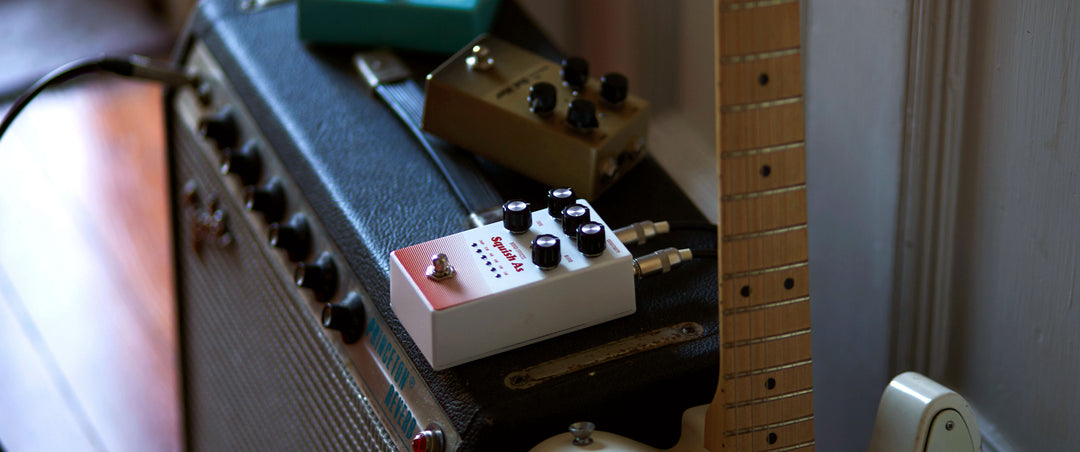Until recent years the technology in compressor pedals was not very good. My first compressor was an old Ross Compressor. I felt like it cut the high-end, made everything too quiet and changed the feel in a very unpredictable way. I could never figure out how to use it or why my favourite guitarists said it made them sound better. Later I bought an Origin Effects Cali76 which was a significant improvement in function and fidelity. The preamp nailed the iconic 1176 sound and distorted in a really musical way, but because I leave my compressor always-on, I realised that what I really wanted was a compressor that did not fundamentally change my tone.
That is why I developed the Squish As Compressor. Built around a best-in-class Blackmer® VCA and True-RMS detector, it delivers natural, high-fidelity dynamics processing without colouring your tone. You can use it to make notes sound more consistent, tame peaks, and boost subtleties; or add depth to your tone with parallel compression by setting the Ratio high and rolling back the Blend control. The Squish As is the perfect always-on compressor.
That's not to say that you can't achieve a more obvious effect if you need it. Setting the Ratio and Blend higher will make the compression much less subtle, but it will never colour your tone, only reduce the dynamic range to add fullness and improve consistency.
Below are some design notes that I have written up to explain how the Squish As works and some of the design choices. I hope you find them helpful!
Tech Specs:
- Best-in-class Blackmer® Voltage Controlled Amplifier (VCA) and True RMS Detector
- Input Impedance: 500kΩ @ 1kHz
- Output Impedance: 560Ω @ 1kHz
- Input Level: Rail to rail, approx. +12dBu
- Output Level: Rail to rail, approx. +12dBu
- Noise: -96dBu, A-weighted 20Hz to 20000Hz
- THD: Typically less than 0.02%, any compression amount up to 40dB @ 1kHz
- SNR: Typically less than 82dB without any gain reduction
- Full Frequency Response (-3dB): 20Hz to 20000Hz
- Attack Time: Program dependent;-3dB ≈ 42ms, -6dB ≈ 20ms, -10dB ≈ 15ms
- Release Time: 125dB/s or 8ms/dB
- Dimensions: 126.5mm * 66mm * 55mm
- Power requirements: 9V centre negative, < 70mA
Sensitivity and Ratio
The Sensitivity knob is just a Threshold control, but rebranded to be guitarist friendly. Ranges -6.3dBu to -46.3dBu to accommodate a variety of input signals including bass guitar, high output pedals (up to +12dBu), and synthesiser. Signals below the threshold are not compressed. The -96dBu noise floor is low enough that the Squish As can be used anywhere in the chain. Finding the sweet spot with the sensitivity knob can help to make notes sound more consistent, tame peaks and boost subtleties (in conjunction with a little makeup gain).
The Ratio knob ranges from 1:1 to ∞:1. A ratio of 1:1 means no-compression —what goes in is what comes out. A ratio of ∞:1 means the Squish As is essentially functioning as a limiter, and that the signal will never be able to be louder than the threshold. If you are using a heavy ratio, it’s important to remember to boost the signal back with the Output knob.
The simplest way to explain ratio is visually so check out these transfer function graphs:

dB for beginners: Decibels (dB) are a unit of measurement used to express the relative intensity or level of a sound. Some useful ones include:
- 6dB is 2x as loud
- 20dB is 10x as loud
The LEDs are not just for pretty colours. I've found that to understand what a compressor is actually doing, the most helpful thing is visual feedback. That's why I have added a gain reduction VU meter to the Squish As. The VU meter indicates the amount of gain reduction in decibels that is happening at any time. I want Squish As to be the compressor you can actually understand.
Output, Tone and Blend
The Output knob controls the compressor’s makeup gain. Its range is -20dB to +20dB, and at noon is unity gain with the dry signal when no gain reduction is present.
The Tone knob is a tilt-style tone control, centred at 900Hz. It only affects the compressed signal, so if you turn the Blend counter-clockwise you will hear its effect fade out.
The Blend knob controls the ratio of Dry-to-Compressed signal, with both signals at unity gain when no makeup gain is present. You can add depth to your tone with parallel compression by setting the Ratio high and rolling back the Blend.
Why no Attack and Release Knobs?
The Squish As Compressor’s attack rate is programme dependent. Put simply, the harder you play, the faster the attack.
The attack rate is proportionate to the power of the input signal, so the further the signal is past the threshold, the faster the attack. The attack rate is independent of the ratio. It’s important to remember that in the Squish As Compressor the attack and release are rates, not fixed periods, so think in decibels per millisecond (dB/ms) rather than fixed milliseconds.
The mathematics behind this are fairly complex, but some useful rules of thumb at a 2:1 ratio are:
- 3dB gain reduction will take approx. 42ms
- 6dB gain reduction will take approx. 20ms
- 10dB gain reduction will take approx. 15ms
- 20dB gain reduction will take approx 5ms
Because the release does not depend on an input signal, the release rates are a little simpler to understand. The release is fixed to the internal timing constants in the Squish As at a rate of 125dB/S or 8mS/dB. The resulting attack and release rates mean you will always have a slower release relative to the attack.
Some useful rules of thumb are:
- 10dB recovery will take approx. 80ms
- 20dB recovery will take approx. 160ms
- 30dB recovery will take approx. 240ms

Thanks for reading!


Leave a comment: